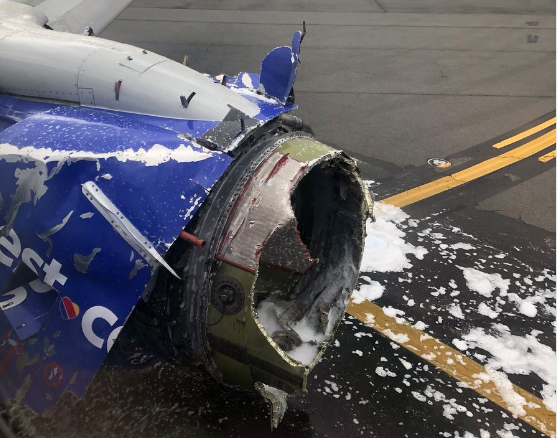Here’s Why They Think That Tragic Southwest Flight’s Engine Exploded

Southwest Airlines officials say the airlines will accelerate inspections on the fan blades of CFM56 jet engines similar to the type that exploded in flight on Tuesday forcing an emergency landing and resulting in the death of a passenger.
In an initial media briefing on the emergency aboard Southwest Airlines Flight 1380 on Tuesday, National Transportation Safety Board (NTSB) Chairman Robert Sumwalt confirmed that a fan blade had separated from the Boeing 737’s jet engine and was still missing. According to Sumwalt a piece of the blown engine’s cowling was recovered near Bernville, PA, located about 70 miles from Philadelphia International Airport (PHL) where the plane made an emergency landing flowing an engine explosion that occurred shortly after the Dallas Love Field (DAL)-bound flight departed from LaGuardia Airport (LGA).
Sumwalt told reporters that a preliminary inspection of the engine indicated that a fan blade separated from the engine “right at its hub,” sending shrapnel into the fuselage and resulting in the death of a passenger. He explained that there were some signs of “metal fatigue” evident in the components involved.
Faced with newly raised concerns about the integrity of the jet engine parts believed to be involved in Tuesday’s emergency, Southwest Airlines announced that the carrier would would step up inspections of similar engines in its fleet out of an “abundance of caution.” Company officials say those inspections will start right away and take place over the coming weeks.
“Southwest Airlines today has announced that it is accelerating its existing engine inspection program relating to the CFM56 engine family,” Southwest officials said in a statement on Wednesday. “The accelerated inspections are being performed out of an abundance of caution and are expected to be completed over the next 30 days. The accelerated checks are ultrasonic inspections of fan blades of the CFM56 engines. The airline expects minimal disruption to the operation during the course of the inspections.”
The airline told FlyerTalk that the 18-year-old aircraft involved in the incident entered service in July of 2000. The Boeing 737 was inspected and found to have no problems just two days before the fatal accident this week.
Additionally, “The aircraft’s last scheduled maintenance check performed was a MV-2 check on Sunday, April 15—just two days prior to the event. A MV-2 check is a general visual inspection on the inlet, exhaust, cowlings, and fairings; and it also includes engine oil servicing,” according to the email from Southwest.
“The next scheduled blade lube, and the first ultrasonic inspection on the number one engine of aircraft 772, was scheduled to be accomplished in December of this year. The number one engine had just over 40,000 total cycles on it, and 10,712 cycles since its last overhaul. A cycle is one takeoff and landing—and an engine overhaul limit is 20,000 cycles.”
The airline expressed “its deepest, heartfelt sympathy to the customers, employees, family members and loved ones affected by this tragic event.” Crew members were praised by company officials for preventing the terrifying incident in which a mother of two lost her life and seven other passenger were injured, from becoming a much worse tragedy.
“This is a sad day and on behalf of the entire Southwest family, I want to extend my deepest sympathies for the family and the loved ones of our deceased customer,” Southwest Airlines CEO Gary Kelly said in an emotional statement. “They are our immediate and primary concern … Truly, this is a tragic loss.”
[Photo: Joe Marcus/Twitter]






















